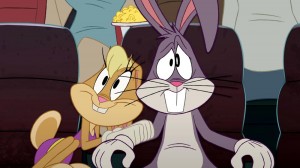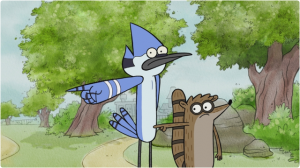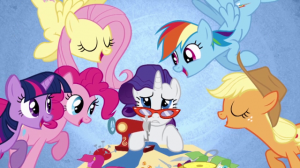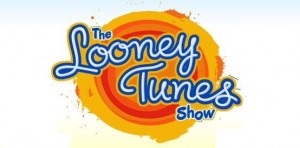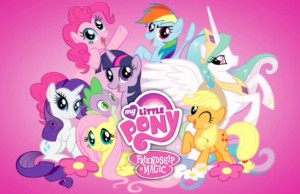Posts Tagged Cartoons
The Rise of the Animated Sitcom, 2.0
Posted by kjohnson1585 in Animation, Television, Writing on June 6, 2011
When an exasperated Bugs tries to passive-aggressively flee a misguided Lola Bunny from her insane belief that the two are dated, he spouts the usual one-liners that would normally invoke an exasperated laugh-track, only to have her respond in kind, invoking another theoretical laugh track. Here, however, Bugs ends up crushed under a giant, weighted barbell, his eyes popping out momentarily as a goofy weight-lifter looks on, confused. Don’t worry, Bugs is a pro. An animated pro.
Welcome to the new animated sitcom. Here, the stories are taken from the well-worn box of typical sitcom tropes and conventions and placed in animated form, but the kicker is that we allow those characters to get hurt, and our conflicts can involve magic and surreal insanity and goofy chaos to resolve them. These characters are real in spirit but fake in action. You’ve seen them before, but not quite like this.
The new animated sitcom differs from the old animated sitcom in that they embrace their cartoony elements more than ever before. The creators adore their squash and stretch roots, their sillier and exaggerated plot-lines, their anvils or otherwise heavy-objects crushing or hitting their characters flat along with their rooted, serial dilemmas easily solved within a 22-minute period. They aren’t The Simpsons, or King of the Hill, or Bob’s Burgers. They’re not Animaniacs, Freakazoid, or Spongebob. And they aren’t Batman, Justice League, or Ben-10. They are an oddly perfect mix of the three.
It was birthed in the fires of Family Guy, but sloppily regulated to cutaways and minor sight gags. It was fine, but MacFarlane’s titular show was always emphatic on the pop-culture gag and, in the end, falling back on the typical sitcom tropes we know and love (or tolerate). While Family Guy post-cancellation has been a hodge-podge of a mess (American Dad seems to be the stronger show nowadays, with also an firmer grip on its cartooniness and sitcomy-ness), the first three seasons broke the physical wall of what an animated sitcom could and should do. It said that animation should and could be, at times, goofy and silly. It is a fucking cartoon after all; maybe, on occasion, can it act like one?
Of course, critics don’t really care too much for such antics; when animated sitcoms get too “cartoony,” this is considered a bad thing. Take a moment and think about this, and reveal in the unaware irony. It’s good to know that the newer batch of critics and viewers, those of use who grew up on Rocko’s Modern Life, Angry Beavers, Invader Zim, and Eek The Cat are a little more lenient when, god-forbid, a cartoon act like a cartoon sometimes. Of course, our tastes and expectations change. We’re older and we’d like to explore older themes. We love our wallabies and beavers and aliens and (non)helpful felines, but now we want something a bit more deeper.
Family Guy was the trigger, but the first cartoon to really embrace cartoon and sitcom alike was Regular Show. It’s somewhat hindered in it’s 2 x eleven minute short format, but it’s a cartoon and a sitcom all the same. Two kids with a somewhat backbreaking job while trying to find ways to slack off and party? How many times have you seen shows like this come and go on ABC, CBS, FOX, and NBC? Of course, those shows don’t end with a powerful being of the likes of Party Pete floating in the air and glowing. Or it doesn’t have a song that sends objects and creatures, literally, to the moon.
And yet there’s a heartfelt style to it. The dialogue is goofy and the beats in the early parts of the episodes are quiet, low-key, verbal based. They say they’re “pissed off” and “what the ‘f’.” They are frustrated by crappy video games and annoying friends, but are somewhat impressed by their boss who both hates and loves them. Regular Show kinda reminds me of the new Comedy Central show Workaholics, but more cartoony, more appreciative of its animated format. A few times, I’ll say to myself, “Ahh, so that’s why this is animated.” I couldn’t say that for King of the Hill.
People will be confused and ask who this is for. Who is the audience? It’s for you, guys. Anyone who understand the nature of demographics is in that demographic. Another great irony. Of course it doesn’t get as deep or life-reflexive as a typical sitcom. There are no character or story arcs as far as I can see. But re-occurring characters are committed to their roles, and the characters have a real, grounded place and real, grounded stakes.
Enter Lauren Faust and My Little Pony: Friendship is Magic.
I wrote about this before, but My Little Pony is the first real show to gauge itself as both a sitcom and a cartoon. It’s easy to focus on the cartoon elements, due to the colorful cast, the pun-based terminology, the expressions and squash-and-stretch emphasis, and the crazy situations the characters get into. However, the characters are deep and unique, the stories are grounded (in MLP-world terms), and there is indeed a story arc, or at least a consistency to the world Faust has created. The only thing that holds it back is it’s perceived demographic (young girls), but as far as the internet is concerned, My Little Pony is for everyone. And it’s a full 22-minutes, too.
Other shows can be argued to be part of the Animated Sitcom, 2.0, but fall short. Ugly Americans utilizes an exotic cast of wizards, werewolves, and robots as legit, fleshed-out characters; it’s limited animation holds it back, however, keeping it along side Futurama and most content on Adult Swim. It’s rare to see the characters of those shows really embrace their cartoony natures. I won’t count action cartoons either, as 1) they aren’t really cartoony and 2) they really aren’t sitcoms. (Batman: Brave and the Bold comes close, but it’s too removed from the “sitcom” trope and is firmly in the action realm.) Phineas and Ferb seem like a good candidate, although character depth is more or less focused on the characters of Candice and Doofenshmirtz, there’s no central theme (beyond two boys making the most of their summer), the 11-minute format is too restricting, and warmer, subtler moments come too few and far in-between to register any poignancy (although there is quite a bit of potential on the peripheral, like Doofenshmirtz’s daughter.) Likewise with Fairly Oddparents and TUFF Puppy. In fact, if you want something closer to compare this phenomenon to, look to the classic Disney Afternoon block from the 90s, where each ‘toon fully embrace it’s 24-minute timeframe for a solid, character-rich show with some pretty fun cartoony elements (although lacking in the sitcom department, there was a few basic elements from it, mostly among character relationships).
(As an aside: a lot of live-action kids TV shows seem much more cartoony than not these days, with their outlandish premises and storylines, like iCarly, The Wizards of Waverly Place, and Hannah Montana.)
With the new Looney Tunes Show embracing that dual role of both cartoon and sitcom, probably in the strongest fashion thus far (although it lacks both 1) the manic energy and 2) a coherent, fleshed-out world as tightly created as MLP), we’re slowly entering a brand new era of the late night, 8pm entertainment. It’s interesting to note that as of a few weeks ago Seth MacFarlane acquired the rights to reboot The Flintstones, arguably the first animated sitcom of its era, a show brimming with cartoony potential but held back by Hanna-Barbara’s limited animation. It’s interesting to see where he takes it; there is a chance that it will be a lame, pop-culture riddled mess, but there’s also a chance it could be a fairly fun, silly animated sitcom as well – after all, he did do typical cartoons before he received FOX money.
It will be interesting to see if Cartoon Network, Nick, or some of the outlier networks like Spike, Comedy Central, or FX start to snatch up sillier cartoon fare with a sitcom base. It would be nice to see more animated sitcoms embrace the “animated” portion of its namesake versus the “sitcom” part, and it looks like we’re seeing more of this in the coming years. Here’s hoping audiences love it as well.
The Looney Tunes Show – Review
Posted by kjohnson1585 in Animation, Television, Writing on May 16, 2011
I usually try not to do straight-up, out-and-out reviews, but I feel like The Looney Tunes Show do warrant at least a bit of a discussion, since there’s been a lot of talk, mostly negative, about this reboot. This cast of wacky characters, made immortal by the likes of Tex Avery, Robert McKimson, and Chuck Jones, have been thrust back into the limelight in a more generic, suburban area, redesigned in look and style. They are essentially goofy animals in a sitcom instead of characters in random, crazy situations. The “Looney” is hardly even touched upon, and the “Tunes” are relegated to 2-3 minute shorts which has a character singing about something dumb (perfect for the inevitable Youtube promo). And yet, I have to admit what I’ve seen was… rather entertaining.
It’s a tricky game. Essentially, in placing Bugs, Daffy, Porky, Speedy, and the rest in a sitcom, we’re entering territory which would usually involve character development. Not to say that they don’t deserve a bit of development, but it’ll be interesting to see how the writers will toe the line of keeping these characters fresh without retconning them to create audacious or inconsistent backstories or histories. Not many people are asking exactly how Bugs developed his acerbic, sarcastic wit, and whether it was in high school or college, and whether he went to those two places at all. So it’s easy to avoid that early on, but come season 2? I wish you luck.
The redesigns, for some reason, don’t look good in still photos, but work very well in motion. It’s refreshing to finally see models that have solid design, recognizable body types, and weight to them, designs that don’t look like they we’re created by interconnected straight-lines and/or what some have been calling “notebook doodles”. One of my favorite moments in Cats Don’t Dance was a simple scene where Danny and Miss Dimple talk back and forth at a table, and just watching them interact, watching their expressions and reactions and body language, was a real treat. And in a way I see that here. The sitcom elements actually work to emphasize the face and body. Animators can concentrate their efforts on the simpler movements and expressions, and you can tell these animators are truly enjoying it. (Although, anything below the waist looks kinda crappy. Daffy’s feet look like spikes, and Bugs feet are big, round Chi-pets.)
May 10th’s episode consisted of Bugs and Lola going on a date, while Daffy uses someone’s club ID number to schmooze in a fancy country club. The pacing and gags were solid, but nothing spectacular. Lola has went through the largest character change, from a strong, aggressive basketball player to an athletic, talkative crazy geek. The change-over, in theory, makes since. Space Jam Lola is pretty much impossible to develop in any long-term way. New Lola (NuLola?) can be mined much more for jokes, and seeing that she’s voiced by SNL star Kristen Wiig, there’s no need to worry about the comic timing. Still, the little things bother me, mainly the fact they moved her away from basketball (here, she plays tennis).
It’s clear that most characters will be regulated to jobs and roles that fit their character personalities. We probably will see Lola in most athletic events. Pepe Le Pew appears as the wedding planner (calling it – future roles include: interior designer, theater director, love guru). Porky seems to be the guy that never has pants (which is weird, since neither does Bugs or Daffy). I’m not sure how deep they’ll go in explaining how they make their money, but I’m somewhat fine with that.
What IS a nice surprise is the adult undercurrents the show has, which is probably the best throwback the 60s and 70s creators and writers could do. Remember, the classic cartoons were pretty risque by today’s standards, so it’s nice to see them push those boundaries, if even by increments. I was surprise to hear Lola mention flat out that “she had to pee”. Pepe gives both Lola and Bugs kisses upon introductions, and his sexual proclivities are pretty obvious (he was married 7 times, and steals Lola at the end for a potential 8th.) We probably won’t have characters shooting each other, but I think we’ll have some sly humor and relatively mature innuendos here and there. There’s no fart jokes, so there’s a start.
I don’t love the new show, but there’s a bit of potential, and it’s certainly no “Lunatics”. I’ll be keeping my eye on this. You should too, as I think we’re entering a new era in animated cartoons. (Tune in next week to see what that is.)
The Surprising Cult-Popularity of My Little Pony
Posted by kjohnson1585 in Animation, Television, Uncategorized, Writing on February 7, 2011
What’s up with the sudden love for MLP?
For those not in the know, MLP stands for My Little Pony. For those really not in the know, the veritable toy line and 80s cartoon was rebooted under the name My Little Pony: Friendship is Magic in 2010 by Hasboro’s own network “The Hub,” to, er, essentially create a new toy line. While there’s nothing new here in conception, the result seems to have given birth to a host of cult fans across the internet, including a few fan forums and chat rooms filled with supporters constantly touting the show’s value. And the scary part is, they are full-grown adults.
Let’s slow down a moment. First, it’s important to emphasize the cult status of the show, especially since Internet popularity doesn’t exactly mean much in terms of the average consumer’s notion of popular culture. In addition, “Buy My Product” cartoons always carry a stigma of blatant financial pandering – a marketer’s paradise where kids line up to acquire action figures, dolls, bedspreads, key chains, pogs (pogs are still a thing, right?), and countless other pieces of merchandise – and maybe, just maybe, they’ll watch the cartoon on occasion.
I often take issue with those instantly dismissive of toy-based entertainment. Sure, it’s obvious that the primary drive is skewed towards the “toyetic” aspect of the franchise versus actually creating a quality cartoon; that doesn’t mean that the cast and crew can’t be dedicated enough to try and create a quality show/movie/comic regardless. Something that’s inherently property-based doesn’t automatically mean it’s shitty – see, Clue. And it’s pretty great to draw as much entertainment from My Little Pony as I would from something like Spongebob Squarepants.
It helps that the show is run by Lauren Faust, wife to Powerpuff Girl and Foster’s Home for Imaginary Friends creator Craig McCracken, whose influences are apparent (the relation between PPG and MLP is so obvious it isn’t worth exploring). Make no mistake, though: it is Faust’s creativity and design that shines through here, to the show’s ultimate benefit. MLP works carefully in defining distinct pony personalities, always an important element in large ensamble TV shows, particularly animated ones (were there any distinctive character in the original MLP or even something like Care Bears?). Its stories are simple but engaging, non-pandering, and disguise its life-lessons well enough in surprising, well-thought out plots and mythologies. It’s a great example of going all out with a simple idea, and reaping the rewards.
Still, it’s popularity is something of a mystery. We’re talking colorful, magical, bright-eyed ponies here, with situations that leave our protagonists afflicted with punned-based diseases, such as – are you ready? – Poison Jokes. (You see, it’s like Poison Oak, but afflicts you with a gag-based symptom.) And while that sounds cringe-inducing, it works very well with the show because of the cast’s commitment to the conflict. There’s no “cutesy-cooties” stories here, and no shoed-in lessons or random-academic facts. Pun aside, Poison Jokes is serious fucking business to the ponies.
Bright, fluid animation with (I assume) Flash and excellent voice talent elevates the show to another level of quality. Solid stories and great characters brings it up another notch (which makes it leagues above the “reptiles talking about nothing” monotony of Dragon Tales – the animated version of Gilmore Girls). However, I’d attribute one extra thing that really makes the show shine beyond more cartoons of a similar nature. You probably didn’t think of this, but this simple feature is what I think allows it to surpass the nature of simple kid’s interest and into genuine, adult-likeability:
Episodes are 22-minutes long.
It always surprises me that more modern-day cartoons don’t adhere to the full 22-minute time frame for an episode, opting to create two 11-minute shorts instead. I’m not referring to the Fox/Comedy Central ‘toons, which are more or less animated sitcoms (although Drawn Together blurred that line), nor to “action” cartoons, like your GI Joes, Transformers, or Marvel/DC animated programs. I refer to what Jeffery Scott in How to Write for Animation calls “squash-and-stretch” cartoons, your mid-day and early evening animation on networks like Nickelodeon or Cartoon Network: Angry Beavers, TUFF Puppy, Regular Show, Chowder, and so on. If an episode of shows like these use all 22 minutes for one self-contained story, it’s probably because it’s a special of some sort. Otherwise, you’re probably getting two shorts instead of one.
Granted, I can understand why it is done. Executives fear alienating the young audience by splitting a show into two parts through commercials. Also, it’s slightly easier to produce two shorts with a team of people (regulating directors and animators focusing on their proper specialties) than it is to collaborate an entire team to one full episode. Still, in the age of DVR and Youtube, and in a time when streamlining the workload is much cheaper and easier, squash-and-stretch cartoons ought to utilize their entire timeslot to the fullest.
Quite frankly, 22-minute episodes tend to be better than the 11-minute ones. The pacing is spread out better and jokes and movements aren’t as crammed together. We can learn about the characters more, get a sense of their personalities and their behaviors, as well as their interactions with each other. Think about it this way: squash-and-stretch cartoons use the 22-minute format during specials mainly to reveal “secrets” or “surprises” about the characters or their world – you know, that thing called “development”. If a squash-and-stretch cartoons worked off the 22-minute template every time, they could “develop” the characters and the world every time. A no-brainer.
The 2 x 11-minute template only leaves room for the story, under the belief that there isn’t a strong need to develop much else to the show besides the plot. With 22-minutes, characters can shine, the plot can create larger stakes, and the limits of the confined setting can be explored to its fullest potential (provided there isn’t any pointless padding). I’m personally not a huge Invader Zim fan, but I’ll admit that loved the pilot and it’s mid-season, planet-riding episode, both of which were 22 minutes. Phineas and Ferb mixes 1 x 22-minutes with 2 x 11-minutes episodes quite frequently, and while both formats are fun, the 1 x 22 have more going for it in terms of character, interactions, and aesthetics. There’s more energy. There’s more investment. There’s more commitment. And this is what I believe makes the My Little Pony show such a treat. Heck, it’s why Sesame Street and Blue’s Clues fairly entertaining to adults, too. It commits us to the entire episode of the show.
While I’ll avoid an entire episode analysis of what works here, a cursory glance at the first five minutes reveals quite a bit. In about thirty seconds, we learn about the two main characters, and a third who apparently controls the clouds. Right after – we hit the ground running with a conflict: all the ponies are in hiding. The plot begins quickly, a la a 11-minute cartoon. But the beats switches quickly to a vaguely sitcomy-type development. In the darkness of the house, we learn point-blank how each pony works and thinks; different voices, actions, behaviors and reactions to this “zebra” illicit similar fears but different responses to that fear. We learn (quite comically, but paramount to in-world development) that they exist in a realm that finds the laws of nature strange, crude, and barbarically horrific. And instead of moving towards the episode climax, the stakes are ratcheted up even higher when the younger pony strikes out on her own to confront this strange striped creature. In essence, we have all the quick-to-the-punch elements of typical 11-minute cartoon, the character-interplay and pacing of a sitcom, and the diegetic development and rising conflict notorious to action cartoons. People may say the writing is good, but it’s because of that 22-minute time frame that the writing can be particularly stellar in conception and execution (bare in mind, the plots are still inherently simplistic, but they go the extra mile to make them appealing).
I’m not rushing to catch every episode, but of the three I have seen, I found myself endeared to the tale being told, mainly because very little of the running time is wasted. Ratcheting up the conflict, keeping the characters distinct and unique (and giving everyone a fair amount of screen time – no one seems wasted), and maintaining those cartoon roots leaves My Little Pony: Friendship is Magic an entertaining, if not too deep, piece of television delight. For comparison, this episode is more sitcomy in plot (a creative take on the other friend replacing you plot-trope), while this one is a more basic, cartoony story (given a harrowing if silly climax). The mixture of elements would be a mess in short form, but 22-minutes is perfect; or should I say, 22-minutes is magic.

